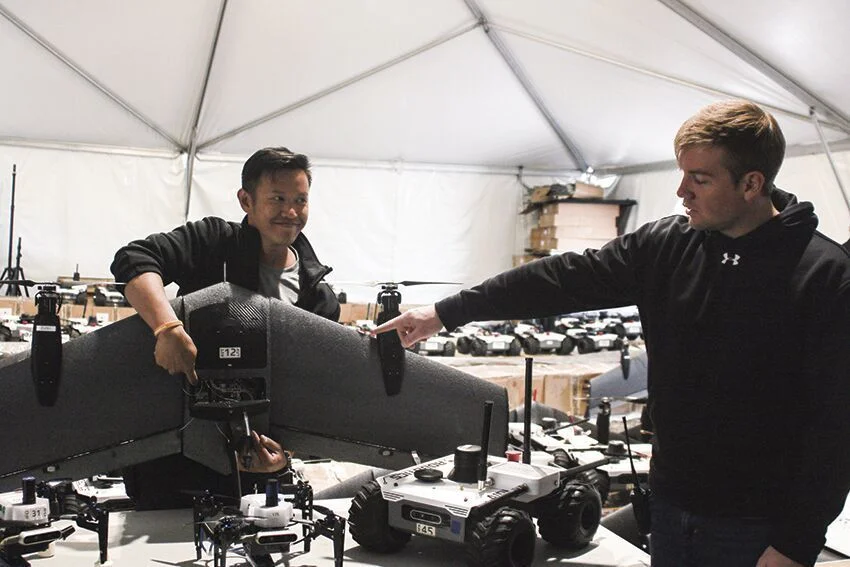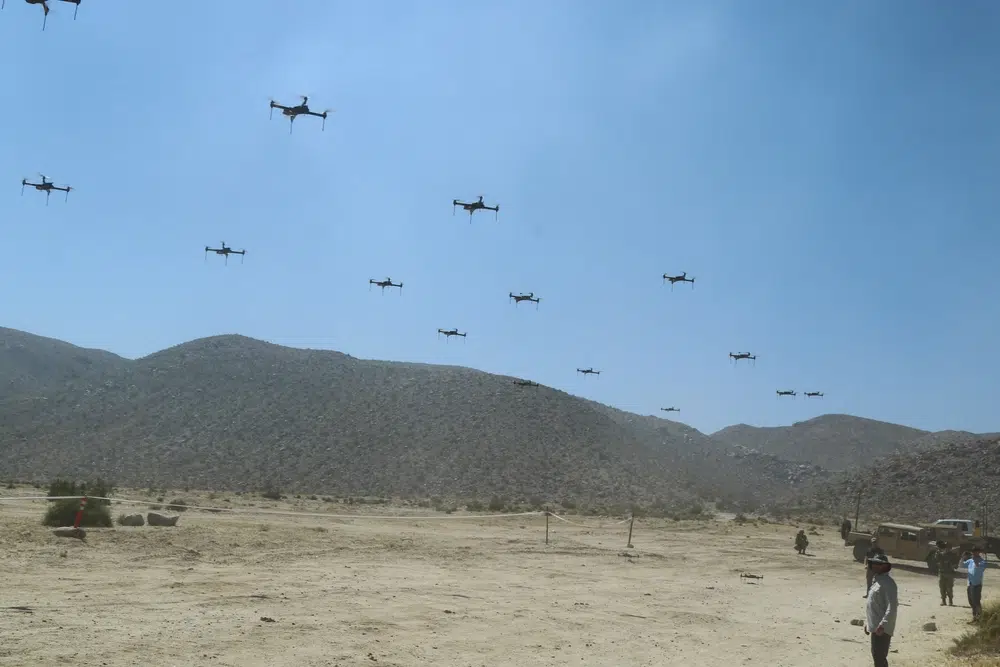Hope Seck

A newly updated program solicitation from DARPA is offering a window into a future in which smart and agile drone “swarms-of-swarms” may be controlled by a single “brain” and be used to overwhelm enemy defenses from the air, land, and water.
DARPA, the Pentagon’s advanced research and development agency, is calling the program AMASS, for “Autonomous Multi-domain Adaptive Swarms-of-Swarms.” In a presolicitation originally published in November and updated in late January, the agency is calling for companies to signal interest in developing an experimental program to develop a command-and-control (C2) system for these envisioned autonomous drone swarms-of-swarms.
The C2 system should have a common language for counter-access/area denial (A2/AD) capabilities, according to the document, and be designed to focus on specific regions and scenarios based on expected future conflicts and challenge areas.
 The 11th Armored Cavalry Regiment and the Threat Systems Management Office facilitate a drone swarm of 40 drones during the battle of Razish, National Training Center on May 8th, 2019. This exercise was the first of many held at the National Training Center. (U.S. Army Photo by Pv2 James Newsome)
The 11th Armored Cavalry Regiment and the Threat Systems Management Office facilitate a drone swarm of 40 drones during the battle of Razish, National Training Center on May 8th, 2019. This exercise was the first of many held at the National Training Center. (U.S. Army Photo by Pv2 James Newsome)“Proposed research should investigate innovative approaches that enable revolutionary advances in science, devices, or systems,” the solicitation states.
Behind this requirement is a need to stay ahead of sophisticated peer and near-peer adversaries with near-impenetrable defensive force fields and the capability to deploy drone armies of their own.
“Today, our peer-state adversaries could invade their neighbors with little warning given their time-distance-mass advantage,” the presolicitation states. It added that enemy A2/AD standoff “bubbles” are very effective at keeping U.S. and allied operations at bay and limiting their ability to engage targets inside that buffer zone.
(As The Debrief, which also reported on the presolicitation, noted, this threat description, and the emphasis on specific regions and scenarios, seems particularly tailored to the threat of a Chinese invasion of Taiwan. The Defense Department hasn’t weighed in on that).
 Dan Nguyen, systems engineer, Northrop Grumman, left, and Adam Seiwert, software engineer, Northrop Grumman, give attendees a closer look at the unmanned vehicles used in the OFFensive Swarm-Enabled Tactics, or OFFSET, program during its final field experiment at Fort Campbell’s Cassidy Range Complex Nov. 16. Researchers with the Defense Advanced Research Projects Agency, or DARPA, designed OFFSET with the goal of allowing infantry units to use swarms with upwards of 250 drones to accomplish diverse mission objectives in urban environments.
Dan Nguyen, systems engineer, Northrop Grumman, left, and Adam Seiwert, software engineer, Northrop Grumman, give attendees a closer look at the unmanned vehicles used in the OFFensive Swarm-Enabled Tactics, or OFFSET, program during its final field experiment at Fort Campbell’s Cassidy Range Complex Nov. 16. Researchers with the Defense Advanced Research Projects Agency, or DARPA, designed OFFSET with the goal of allowing infantry units to use swarms with upwards of 250 drones to accomplish diverse mission objectives in urban environments.Long-range precision-guided weapons, a key focus in recent years for military services including the Army and Marine Corps, are still limited and expensive, and need detailed targeting information that isn’t always available, it adds. And while submarines can be effective at thwarting enemy defenses, they also represent a significant risk to human life if they are detected and targeted. In an effectively defended A2/AD environment, drones are the best solution: smaller systems might be less likely to trip enemy defenses, and even if found and targeted, they’re far more expendable than a conventional air, ground, or sea platform with humans on board.
The challenge, the description notes, then becomes how to control large quantities of unmanned systems from a great distance.
“Current unmanned platforms require frequent or constant communications, which may not be possible in real-world scenarios,” a synopsis document states. “
The Services and Coalition partners are making significant investments in artificial intelligence and autonomy to enable [unmanned aerial vehicle], [unmanned surface vehicle], and [unmanned ground vehicle] platforms to function independently in A2/AD environments, but have yet to achieve the large-scale, dynamic autonomy necessary to be effective against a peer state adversary’s A2/AD capabilities.”
 The 11th Armored Cavalry Regiment and the Threat Systems Management Office hold a drone swarm of more than 40 drones to test the rotational units anti-air capabilities during the battle of Razish, National Training Center on May 8th, 2019. This exercise was the first of many held at the National Training Center. (U.S. Army Photo by Pv2 James Newsome)
The 11th Armored Cavalry Regiment and the Threat Systems Management Office hold a drone swarm of more than 40 drones to test the rotational units anti-air capabilities during the battle of Razish, National Training Center on May 8th, 2019. This exercise was the first of many held at the National Training Center. (U.S. Army Photo by Pv2 James Newsome)AMASS aims to solve these problems by building a central brain for all kinds of inexpensive, expendable unmanned systems that will enable them to break through the A2/AD force field and coordinate their operations throughout an entire war theater.
The centrally controlled swarms-of-swarms, possibly made up of thousands of individual drones, will “simultaneously threaten multiple high-valued adversary assets, introduce intolerable cost-exchanges, and enable Joint Force and Coalition operations within the A2/AD bubble,” the description states. In other words, these superswarms will be able to do significant damage to the enemy without costing friendly forces much at all.
Previous DARPA experiments, the description notes, have shown that drone swarms are most effective when they’re autonomous and include several different platforms and payloads. While air, ground, and sea drones are mentioned specifically in the presolicitation, a clarifying document released later notes that the swarms may also include unmanned undersea vehicles – drone submarines.
 The 11th Armored Cavalry Regiment and the Threat Systems Management Office operate a swarm of 40 drones to test the rotational unit’s capabilities during the battle of Razish, National Training Center on May 8th, 2019. This exercise was the first of many held at the National Training Center. (U.S. Army Photo by Pvt. James Newsome)
The 11th Armored Cavalry Regiment and the Threat Systems Management Office operate a swarm of 40 drones to test the rotational unit’s capabilities during the battle of Razish, National Training Center on May 8th, 2019. This exercise was the first of many held at the National Training Center. (U.S. Army Photo by Pvt. James Newsome)As part of this new experimental program, DARPA wants to develop a new common drone language it’s calling the “Swarm-of-Swarms Protocol,” or SOSP. This language would allow the central control system to communicate with the various kinds of drones in a way that sounds strikingly similar to how a commander might communicate with human troops, using the SOSP language to “request services, negotiate, and exchange information with swarms that are available in the region.”
The to-be-developed command-and-control architecture would help to determine the ideal drone swarm size and what kind of communications drone armies require for maximum effectiveness. It would also help to make them resilient to hacking and other forms of enemy cyber intrusion.
Drone swarms have been a longtime development focus for multiple military services, both in the U.S. and among other major militaries. Last May, a video surfaced showing a Chinese 10-drone swarm capable of cleanly navigating a dense bamboo forest without human inputs.
Click to accept marketing cookies and enable this content
The U.S. Army is incorporating drone swarms into training as well. In September, a unit at the service’s National Training Center in California launched a swarm of 40 quadcopters, forcing troops on the ground to defend themselves from and track the airborne threats.
At sunrise this morning a swarm of 40 quadcopters all equipped with cameras, MILES, and lethal munition capable launched in advance of 11th ACR’s attack on a prepared defense by 1AD. Drones will be as important in the first battle of the next war as artillery is today. pic.twitter.com/zPQ2I8SoqN— NTC Lead 6 (@NTCLead6)September 11, 2022Click to accept marketing cookies and enable this content
DARPA itself has for years been working on a separate drone swarm project called OFFSET: the OFFensive Swarm-Enabled Tactics Program. This effort aims to create a swarm of some 250 drones equipped with artificial intelligence, capable of operating in densely populated urban areas and collecting intelligence or securing targets as required.
As with AMASS, this drone swarm would be heterogeneous, with air and ground platforms included.
While the Pentagon recently re-released its policy on autonomous weapons systems to address AI and clarify its commitment to ethical development and operation, the reality that drones will play an increasingly prominent role in warfare is inescapable. The AMASS project underscores the current race for unmanned dominance through systems that are smarter, better coordinated, and more resilient than those fielded by the enemy.
No comments:
Post a Comment